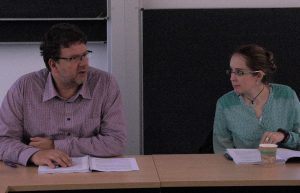Course at the first international Libori Summer School at the Center for the History of Women Philosophers, July 24-28, 2017.
The course Helene von Druskowitz and Modern Misandry consisted of a “small but powerful group” – as Dr. Luka Borsic liked to put it – of students and researchers. The international and intercultural background of the group resulted in great discussions with variegated perspectives on the topic. Dr. Luka Borsic and Dr. Ivana Skuhala Karasman from the University of Zagreb, Croatia, offered an insight in this new field of research, investigating misandry. The class developed like the field of research in general – with very passionate discussions, controversial positions and without any tendency to slow down.

Dr. Luka Borsic and Dr. Ivana Skuhala Karasman.
Misandry can be considered as an accompanying symptom of the women’s right movements/feminism, but also of misogyny. The misandrous texts read during this Libori Summer School were written during the first and second wave of feminism. The first example was the S.C.U.M. Manifesto by Valerie Solanas (1936-1988), published in 1971. Solanas is an extreme example since she did not only express man-hatred in her writing but also assassinated the artist Andy Warhol in 1968, attempting to shoot him. S.C.U.M. is an acronym for Society for Cutting Up Men. Her radical position, starting from the premise that society would flourish if men were removed from it, was foreshadowed by writings published in the 19th and early 20th century.

Participants and lecturers of the course.
The second session opened with the discussion of misogynist text by Schopenhauer, Nietzsche and Freud. Their arguments were used as a point of reference later. The structure of misogynist and misandrous text proved to be similar in many regards: Both types of texts are providing a stereotypical depiction of the sexes and their assumed inferiority or superiority, both are usually written in a polemic style. Even the properties that the authors considered typically male or female proved to be interchangeable.
The texts Uprising of Women and the Third Sex by Elsa Asenijeff (1867-1941) and Pessimistic Cardinal Propositions – Man as a Logical and Moral Impossibility by Helene Druskowitz (1856-1918) were discussed in the third to fifth session. The works by Asenijeff and Druskowitz are German in the original, Dr. Borsic and Dr. Karasman provided an English translation of this material for the first time.
The final session started with the presentation of the students own work on similar topics, and ended with a discussion with regard to misandrous tendencies in today’s society.
(Jessica Harmening)
You cannot copy content of this page








